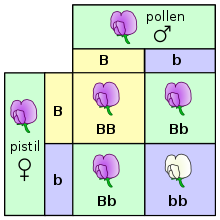Blending inheritance
Blending inheritance is an
Charles Darwin's theory of inheritance by pangenesis, with contributions to egg or sperm from every part of the body, implied blending inheritance. His reliance on this mechanism led Fleeming Jenkin to attack Darwin's theory of natural selection on the grounds that blending inheritance would average out any novel beneficial characteristic before selection had time to act.
Blending inheritance was discarded with the general acceptance of particulate inheritance during the development of modern genetics, after c. 1900.
History
Darwin's pangenesis
I have lately been inclined to speculate very crudely & indistinctly, that propagation by true fertilisation, will turn out to be a sort of mixture & not true fusion, of two distinct individuals, or rather of innumerable individuals, as each parent has its parents & ancestors:— I can understand on no other view the way in which crossed forms go back to so large an extent to ancestral forms."[4]

In a letter to
I do not think you understand what I mean by the non-blending of certain varieties. It does not refer to fertility; an instance I will explain. I crossed the Painted Lady and Purple
sweetpeas, which are very differently coloured varieties, and got, even out of the same pod, both varieties perfect but not intermediate. Something of this kind I should think must occur at least with your butterflies & the three forms of Lythrum; tho’ those cases are in appearance so wonderful. I do not know that they are really more so than every female in the world producing distinct male and female offspring...[7]
Blending inheritance was also clearly incompatible with Darwin's theory of evolution by natural selection. The engineer Fleeming Jenkin used this to attack natural selection in his 1867 review of Darwin's On the Origin of Species. Jenkin noted that if inheritance were by blending, any beneficial trait that might arise in a lineage would have "blended away" long before natural selection had time to act.[1][5][6] The evolutionary biologist Richard Dawkins commented that blending inheritance was observably wrong, as it implied that every generation would be more uniform than the one before, and that Darwin should have said as much to Jenkin. The problem was not with natural selection, but with blending, and in Dawkins's view, Darwin should have settled for saying that the mechanism of inheritance was unknown, but certainly non-blending.[1]
Replacement by Mendelian inheritance

Blending inheritance was dismissed by the eventual widespread acceptance, after his death, of Gregor Mendel's theory of particulate inheritance, which he had presented in Experiments on Plant Hybridization (1865).[8][9] In 1892, August Weismann set out the idea of a hereditary material, which he called the germ plasm, confined to the gonads and independent of the rest of the body (the soma). In Weismann's view, the germ plasm formed the body, but the body did not influence the germ plasm, except indirectly by natural selection. This contradicted both Darwin's pangenesis and Lamarckian inheritance.[10][11] Mendel's work was rediscovered in 1900 by the geneticist Hugo de Vries and others, soon confirmed that same year by experiments by William Bateson.[12] Mendelian inheritance with segregating, particulate alleles came to be understood as the explanation for both discrete and continuously varying characteristics.[13][14][a]
See also
- Aristotle's biology
- Incomplete dominance
Notes
- ^ Blending inheritance has sometimes been wrongly identified with the continuous inheritance advocated by the biometricians at the start of the 20th century. There were indeed disagreements between them and the early Mendelians, but these did not concern blending.[15]
References
- ^ a b c d e Dawkins, Richard (8 February 2003). "An early flowering of genetics". The Guardian.
- S2CID 254544807.
- ISBN 1-4191-8660-4.
- ^ Darwin Correspondence Project, Letter #2166 -- Darwin C. R. to Huxley, T. H. dated before 12 Nov 1857
- ^ a b Bowler 1983, pp. 23–26, 196–253.
- ^ a b Larson 2004, pp. 120–124.
- ^ Darwin Correspondence Project, Letter #4989 -- Darwin, C. R. to Wallace A. R. dated 6 Feb 1866
- ^ Mendel, J. G. (1866). "Versuche über Pflanzenhybriden". Verhandlungen des Naturforschenden Vereines in Brünn. 4 (1865): 3–47.
- ^ Druery, C. T.; Bateson, William (1901). "Experiments in plant hybridization" (PDF). Journal of the Royal Horticultural Society. 26: 1–32.
- ^ Weismann, August (1892). Das Keimplasma: eine Theorie der Vererbung. Jena: Fischer.
- ^ Bowler 1989, pp. 247–253, 257.
- ^ Ambrose, Mike. "Mendel's Peas". Norwich, UK: Germplasm Resources Unit, John Innes Centre. Archived from the original on 14 June 2016. Retrieved 13 December 2017.
- ^ Larson 2004, pp. 157–166, 221–243.
- ^ Bowler 1989, pp. 275–276.
- PMID 24803228.
Sources
- ISBN 978-0-8018-4391-4.
- ISBN 978-0-520-06386-0.
- ISBN 0-679-64288-9.
